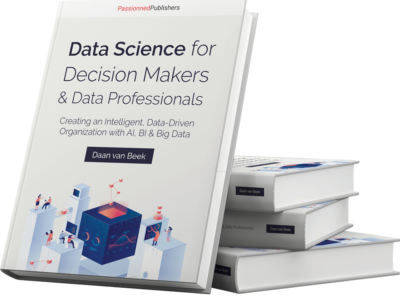Data-driven working stimulates a democratic organization
Data helps chart the real-world impact of existing measures and adjustments, and democratically determine the next steps and actions to be taken. Making data more accessible to more employees creates a democratic foundation for everyone to draw their own conclusions from. The effectiveness of measures can be monitored in real-time and with an eye on the whole. People can look with you, and help decide, enabling collaboration and cooperation. All with an eye on radically or incrementally implementing improvements. Data-driven organizing isn’t just IT’s new plaything. Data-driven working matches what people in the workplace have long felt and known.
Data takes center stage
In this new constellation, managers and their agendas no longer rule the day. The data comes first, and this data is usually lifted directly from the work processes. That makes the data recognizable to people who deal with it in practice every day. The data reveals what people in the workplace (could) have already known.
Have a good conversation based on the facts
Employees will recognize the outcomes of the data and they’ll finally be able to see the results of their work and have a good conversation based on the facts. Data-driven management ensures that people can have a to-the-point conversation about what’s really going on. Thanks to data, organizations can monitor results using facts as a base, and they get more resources to make informed management decisions and course-correct. Typically, employees will be very happy with the implementation of a data-driven organization.
A radical power shift: the data revolution
In parallel to the empowerment of employees as described above, the upper echelons may be reticent to implement a data-driven organization. This structural and fundamental reshaping of the role of employees and management is what we’re calling the data revolution.
Data will expose which management layers are making unjust claims, and which layers are redundant.
If you let data penetrate the core of the improvement processes, you’ll quickly run into the following question: who should have the power and responsibility in the organization? Data can shake things up a lot, especially in organizations with a lot of management layers. Data will expose which management layers are making unjust claims, and which layers are essentially redundant. Data will also often expose people with incorrect business philosophies. Decisions made earlier can still be objectively tested for effectiveness.
The old power base diminishes
The knowledge asymmetry disappears because knowledge is made available simultaneously and objectively. Data-driven working does pull the rug out from under the old power base under a lot of management structures. Many managers and directors aren’t ready for this new openness and transparency. That’s why they block initiatives by pointing out potential violations of privacy legislation when data threatens to play a bigger part.
The Data Science book for Decision Makers & Data Professionals  This brand-new Data Science book covers the most important organizational and technical facets of (big) Data Science, artificial intelligence, and machine learning. In 10 steps, this Data Science book teaches you how to apply Data Science, algorithms, machine learning, and deep learning. Order the book today and start a new way of working.
This brand-new Data Science book covers the most important organizational and technical facets of (big) Data Science, artificial intelligence, and machine learning. In 10 steps, this Data Science book teaches you how to apply Data Science, algorithms, machine learning, and deep learning. Order the book today and start a new way of working.
Data as the new foundation: the bottom-up movement
In order to make actions and follow-up actions (the Do step in the PDCA cycle) optimally match the higher goal, it’s necessary to put all the relevant data on the table. Relevant data is all the information that is related to the issue that people are passionate about and that plans are focused on. This data comes from the lived reality and coincides one-to-one with the everyday reality of the workplace.
The real deal
It’s not about a one-sided presentation of a limited set of numbers that are politically deployed to justify top-down policy. No decision-making based on quicksand and unjust assumptions. It’s about the real deal, the complete picture. Hard data, real numbers, that come from the bottom-up and that everyone can see.
Data as a solid foundation
Data forms the solid foundation for decision-making. Not incidental actions based on random research reports, but actions with an impact that’s measurable by data. At first, it should be visible to the team that’s handling the problem. But preferably it should also be made available to everyone, so that anyone with a passion for that aspect of society can contribute.
Bottom-up versus top-down
Using data as the foundation creates a bottom-up movement. But at the same time, you still need top-down support. You have to be able to free up the finances, people, and time required, after all. The big benefit is that all kinds of new solution directions come from the bottom, based on facts. From the existing data, employees can determine what plans they want to make, which ideas they think are relevant, and which intervention can make a real difference.
The tension between data and privacy
To arrive at a further data revolution, it’s necessary to take the open data from various sources and connect them smartly. For example, open data from municipalities, governments, provinces, and health insurers.
A big challenge when linking data systems is being compliant with privacy regulations, while at the same time working with valuable data streams that differentiate based on relevant personal characters. These have to be anonymized, of course. A data warehouse will be the perfect place to do that.
The difference between anonymization and pseudonymization
Anonymization and pseudonymization are both so-called privacy-enhancing techniques. Several characteristic differences are:
- Anonymization is the irreversible process of making information completely impossible to trace back to the individual. For example, randomization or generalization.
- In the case of pseudonymization, the data is encrypted. That means that with the right key or supplemental data, the data can be traced back to the person.
- Pseudonymization often works with encryption techniques and is thus a reversible process.
Anonymized data falls outside of the framework of privacy legislation and can be analyzed. Pseudonymized data does fall under privacy legislation.
The simultaneous safeguarding of privacy and effectiveness
In order to be able to work with data and comply with privacy legislation, data is typically first filtered through a data warehouse, where the data is anonymized or pseudonymized. Big packets of data are then divided into many smaller packets under professionals.
Every little packet contains the number of cases that the professional can use to plan follow-up appointments, in this case. The professional is then authorized to open their own packet, and they get permission to read that packet. They can find out, for example, who the twenty clients are who were surfaced by the algorithm and what their characteristics are.
The professional can thus, based on his own small packet, look at the people who surfaced in their analysis and their characteristics. This method of working safeguards privacy and effectiveness.
From data to improvement
Data can help you understand what’s happening, monitor plans, and adjust if necessary. The monitoring function ensures that the next action will also be taken. Data legitimizes the Do step. If it’s unclear where the business is, how effects and side effects will work out, it’s very threatening to arrive at a different Do step than people are used to. In the dark it’s easier to stand still than run an obstacle course. Read here more about the data-driven PDCA.
Results from the past
But with data as an organization’s sense, you can provide actions with feedback and a learning loop is generated. People no longer have to stick to an old plan that was grandfathered in. No, the fact that a five-year-old approach was legitimate provides no guarantees for the future. Results from the past offer no guarantees for the future. The data stream will indicate where there is improvement, and where there isn’t.
Data legitimizes action
In a data-driven organization, people aren’t afraid to lose something, because the data stream provides permanent feedback, enabling constant course correction. This is how data legitimizes the Do step. After all, if it turns out that an intervention is ineffective, or can be improved, that will be revealed by the data, which gives insight into what will work in order to achieve an improvement.
A practical example: Rotterdam South
The mobilizing power of the data-driven organization can be seen very clearly in the case study of Rotterdam. In the old situation, management or a city legislator would unload a package of measures over a group of young people. That was supposed to help them out of unemployment.
Nowadays, the data-driven program in Rotterdam South is going full speed ahead. Our colleague Mark de Kort combined data from all the municipal offices, such as unemployment data, welfare data, job seekers, et cetera.
Through an advanced data warehouse, the data is made anonymous during the analysis. But the collective movements of groups can still be detected. We’ll summarize some revolutionary new findings:
- The people in the workplace can look at the data themselves.
- When implementing new interventions, they can set their own priorities and follow their effects in real-time.
- Without having to hand-copy data, they’re capable of following every group collectively. Do you want to know where the people with addictions from X or Y neighborhood are? The system indicates every movement.
- Based on automated data visualizations, everyone can see how certain demographics, like youths, move between various government helpdesks.
- By presenting all the data holistically, you can prevent the data from being presented one-sided to suit a political goal. When all the facts are on the table, you can present an honest and complete picture and judge plans based on their effectiveness. This instantly reveals manipulated numbers.
- Optimistically, city councils and related services are tempted to operate very closely, making them more effective at achieving results. And they can also prevent groups from unintentionally and undesirably being left out.
- Data is a feeding ground for experiments. Data streams form the foundation for testing and developing new plans. Data provides the legitimacy to implement a new Do (D phase of the PDCA cycle). This way you can make a controlled leap from good to great. Or you can bridge the gap between “not as good as we thought” to “excellent”.
- Data reveals all the puzzle pieces. Then you can look at each individual piece and ask: can we place this piece faster, and what do we need to do that?
- Continuous improvement also tackles the possibility of shortcuts. Can we skip pieces of the puzzle because they’re double or don’t add any value? Can we bring their function forward in time? And what do we need to do that?
3 side notes
- If you only look at the actions between being on benefits and employment, it’s factually correct that there were X number of movements from welfare to work. So, at first glance, the city legislator’s interventions seem to work well. Until you look at the complete picture: then you see that there are lots of people who relapsed multiple times and were employed multiple times but kept relapsing into welfare.
- It turns out that at least 80% of that group returns to the benefits system in different places. This can mean they go to a different helpdesk.
- By looking holistically at the actual retention numbers, it turns out that the measures taken don’t work for 1,000 youths, but at most 100. Keep in mind that here, too, the numbers are only an illustration of the problem.
Data-driven leadership is leading people
A big misunderstanding is that data-driven working would lead to a machine-like age where people walk around with Excel sheets or watch dashboards all day, or otherwise spend the day with their heads in the Cloud.
The use of data is actually meant to give power back to the people and provide them with better choice architecture.
Data-driven leadership is about learning and improving, a pre-eminently human skill. Data-driven workers and leaders don’t spend all day at their computers, they’re busy mobilizing their people.
The use of data is meant to give power back to the people and provide them with a better choice architecture.
The leader shows themselves regularly, cooperates, and listens closely to people and what keeps them busy, what drives them, and what frustrates them. That remains the biggest source of inspiration.
Inspiring and mobilizing
We already saw how important inspiration is in the Plan phase. Most managers and directors are at least capable at this. They create a kind of vision. They could say something like “In two years we want to be there, and for this reason”. So, they’re usually not lacking on the inspiration side. But how can you mobilize people so that they work on your plans conscientiously and with dedication and ?
Celebrate the short-term successes
One of the tips that help in leading people is achieving short-term successes. This creates belief in the change. Visible results make it so that a transformation project doesn’t just become believable but is also seen as such. It reduces resistance and creates energy to take the next step.
Don’t forget to spotlight these successes and celebrate them. This convincingly proves how the success was achieved and what the positive impact on the environment was. Organizations that celebrate successes have greater employee satisfaction and team spirit.
Don’t let the energy drain out
The reverse goes too: if there are no short-term successes, the energy drains away, people give up hope, and you lose momentum. People could even start to resist change, even if everyone supports the long-term goal. These successes shape the question of how you can change, after all. Show people that change doesn’t mean that heads will roll, and ensure a positive feedback loop.
Conclusion
The data revolution is in full swing and data-driven working is the future. Just keep in mind: data-driven leadership is about learning and improving, a pre-eminently human skill. Data-driven workers and leaders don’t spend all day at their computers, they’re busy mobilizing their people.



